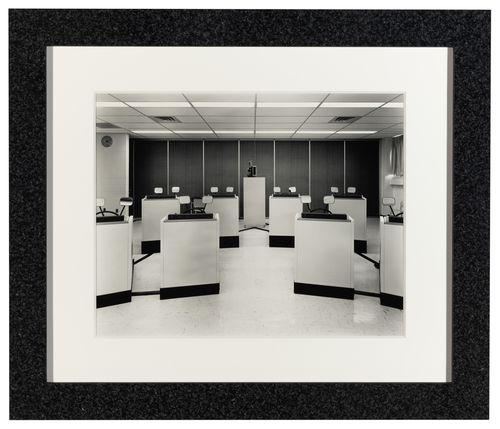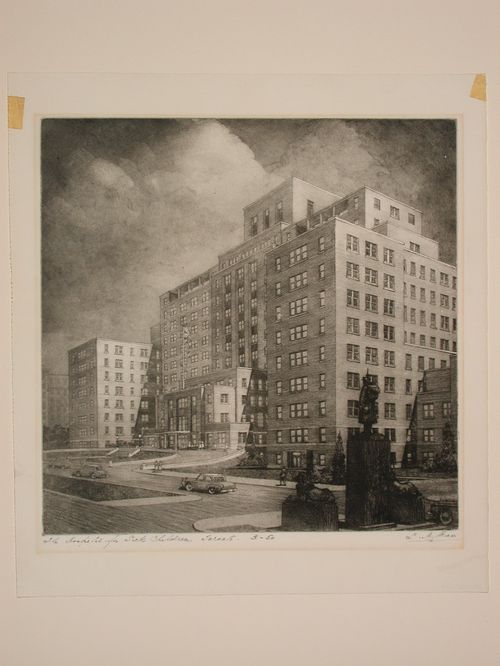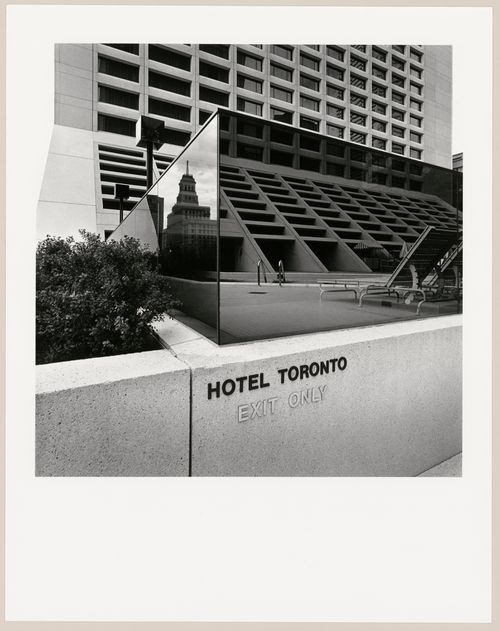Project
AP056.S1.1989.PR05
Description:
This project series documents the design of the Broadcast Centre Development on Front Street in Toronto in 1989. The office identified the project number as 8910. This project, commissioned by Graywood Developments Ltd., consisted of a mixed-use development located on the property directly east of the new CBC headquarters. This project was also referred to as the CBC/Graywood Development in the documentation and was an entry for a site development competition. The project proposed a mixed low-rise and high-rise tower that would contain a hotel and condominiums. The hotel would comprise the first six floors, creating a base for the tower, which would hold residential properties above the eighth floor recreation centre. A triple-height club lounge was proposed at the 43rd floor, visually separating the lower tower from the penthouses above it. These penthouses would be set back from the levels below with a long, pointed tower extending above them to complete the top of the building. This project was never built. The project is recorded through drawings, presentation paintings, a model and photographs of the model dating from 1988-1989. The drawings consist of site surveys, sketches, elevations, sections, plans, perspectives, axonometric drawings and presentation drawings
1988-1989
The Broadcast Centre Development, Toronto (1989)
Actions:
AP056.S1.1989.PR05
Description:
This project series documents the design of the Broadcast Centre Development on Front Street in Toronto in 1989. The office identified the project number as 8910. This project, commissioned by Graywood Developments Ltd., consisted of a mixed-use development located on the property directly east of the new CBC headquarters. This project was also referred to as the CBC/Graywood Development in the documentation and was an entry for a site development competition. The project proposed a mixed low-rise and high-rise tower that would contain a hotel and condominiums. The hotel would comprise the first six floors, creating a base for the tower, which would hold residential properties above the eighth floor recreation centre. A triple-height club lounge was proposed at the 43rd floor, visually separating the lower tower from the penthouses above it. These penthouses would be set back from the levels below with a long, pointed tower extending above them to complete the top of the building. This project was never built. The project is recorded through drawings, presentation paintings, a model and photographs of the model dating from 1988-1989. The drawings consist of site surveys, sketches, elevations, sections, plans, perspectives, axonometric drawings and presentation drawings
Project
1988-1989
drawings
Property data maps prepared by the City of Toronto, Ontario Congress and Trade Centre, Toronto
AP018.S1.1978.PR05.007
1976
Property data maps prepared by the City of Toronto, Ontario Congress and Trade Centre, Toronto
Actions:
AP018.S1.1978.PR05.007
drawings
1976
PH2016:0113
c.1980s
DR1985:0443
20th century
textual records
ARCH254505
photographs
DR2007:0086:003:003
1982
photographs
1982
photographs
PH1997:0010
1972
photographs
1972
Project
AP018.S1.1956.PR01
Description:
This project series documents the design of the residence of J.D. Crashley at 3 Old George Place in Toronto, Ontario from 1956-1965. The office identified the project number as 5614. This project consisted of the design for a T-shaped, one storey home for J.D. Crashley, who was a prominent Toronto entrepreneur and president of the Art Gallery of Ontario in the 1970s. Only the garage was visible from the street, with one of the stems of the T extending over into the adjacent ravine, creating two levels to the residence. The exterior of the residence was largely field stone with brick on some walls. The construction of this home is recorded under a separate project number, assigned by the office (see project series AP018.S1.1959.PR03 in this fonds). Today, the house enjoys special heritage status in Ontario, although the highly controversial addition of a second floor was recently completed. The project is recorded through drawings dating from approximately 1956-1959. The majority of these drawings are original design drawings.
circa 1956-1959
J.D. Crashley Residence, Toronto (1956-1965)
Actions:
AP018.S1.1956.PR01
Description:
This project series documents the design of the residence of J.D. Crashley at 3 Old George Place in Toronto, Ontario from 1956-1965. The office identified the project number as 5614. This project consisted of the design for a T-shaped, one storey home for J.D. Crashley, who was a prominent Toronto entrepreneur and president of the Art Gallery of Ontario in the 1970s. Only the garage was visible from the street, with one of the stems of the T extending over into the adjacent ravine, creating two levels to the residence. The exterior of the residence was largely field stone with brick on some walls. The construction of this home is recorded under a separate project number, assigned by the office (see project series AP018.S1.1959.PR03 in this fonds). Today, the house enjoys special heritage status in Ontario, although the highly controversial addition of a second floor was recently completed. The project is recorded through drawings dating from approximately 1956-1959. The majority of these drawings are original design drawings.
Project
circa 1956-1959
Project
AP056.S1.1992.PR03
Description:
This project series documents interior design work for Creative Copy and Design in Toronto in 1992. The office identified the project number as 9203. This project consisted of interiors for the high resolution imaging company, Creative Copy and Design, located on the ground floor of King James Place at 145 King Street East. The office was made up of an unfinished ground floor and existing mezzanine at the back, totalling 2630 square feet. The ground floor interiors consisted mainly of the reception area, which was visible from the sidewalk through the office's glass storefront. The reception area was comprised of two long, boomerang-shaped counters, and one rectangular counter behind them, made of wood with plastic laminate tops. The wood was stained to match the corrugated wood wall that ran the length of the room, directly behind the three counters. A large, ellipse-shaped lighting fixture made from fibre glass panels and steel stud framing was a prominent feature above the reception area. Bathrooms and a processing area were located behind the wall, as well as a stair case leading to the mezzanine, which contained work stations and an additional processing area. The program also included electrical and mechanical installation. The project is recorded through drawings and photographs dating from 1992. The drawings consist of sketches, a floor plan, and a set of construction drawings with specifications and schedules. The photographs show the completed project.
1992
Creative Copy and Design, Toronto (1992)
Actions:
AP056.S1.1992.PR03
Description:
This project series documents interior design work for Creative Copy and Design in Toronto in 1992. The office identified the project number as 9203. This project consisted of interiors for the high resolution imaging company, Creative Copy and Design, located on the ground floor of King James Place at 145 King Street East. The office was made up of an unfinished ground floor and existing mezzanine at the back, totalling 2630 square feet. The ground floor interiors consisted mainly of the reception area, which was visible from the sidewalk through the office's glass storefront. The reception area was comprised of two long, boomerang-shaped counters, and one rectangular counter behind them, made of wood with plastic laminate tops. The wood was stained to match the corrugated wood wall that ran the length of the room, directly behind the three counters. A large, ellipse-shaped lighting fixture made from fibre glass panels and steel stud framing was a prominent feature above the reception area. Bathrooms and a processing area were located behind the wall, as well as a stair case leading to the mezzanine, which contained work stations and an additional processing area. The program also included electrical and mechanical installation. The project is recorded through drawings and photographs dating from 1992. The drawings consist of sketches, a floor plan, and a set of construction drawings with specifications and schedules. The photographs show the completed project.
Project
1992
PH1979:0512
architecture
8 June 1977
View of Hotel Toronto showing the swimming pool, 145 Richmond Street West, Toronto, Ontario
Actions:
PH1979:0512
architecture


